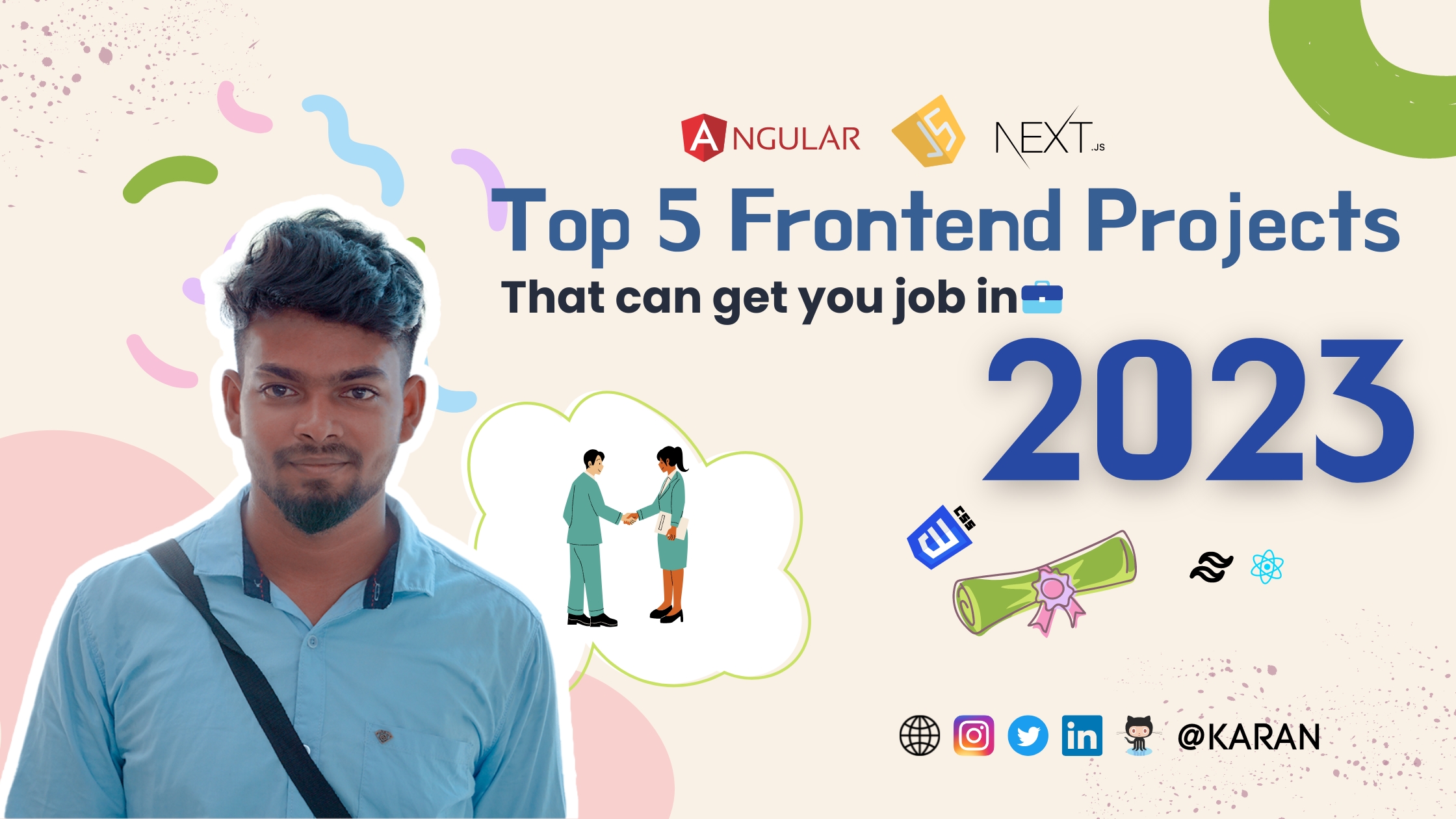Top 5 Frontend Projects that can get you job in 2023
 Karan
Karan
The top 5 frontend projects to get a placement! As a frontend developer, it's important to constantly improve your skills and stay up-to-date with the latest technologies and best practices. One of the best ways to do this is by building projects and experimenting with different techniques and frameworks.
In this post, we'll be discussing five frontend projects that can help you improve your skills and increase your chances of getting a placement. From building a responsive website to a mobile app or game, these projects cover a range of different skills and technologies that are in demand in the industry.
We'll go into detail about each project, highlighting the key skills and technologies you'll need to master, and providing some tips and resources to help you get started. Whether you're a beginner looking to break into the field or an experienced developer looking to improve your skills, these projects are a great way to showcase your abilities and stand out from the competition.
So without further ado, let's dive into the top 5 frontend projects to get a placement!
1. Recreate codepen https://codepen.io/
CodePen is a web application that is built using a variety of technologies, including HTML, CSS, JavaScript, and several open-source libraries and frameworks. Here is a brief overview of some of the technologies that are used in the CodePen application:
HTML: HTML (Hypertext Markup Language) is the standard markup language for creating web pages. It's used to define the structure and content of a web page, including headings, paragraphs, lists, links, and images.
CSS: CSS (Cascading Style Sheets) is a stylesheet language used for describing the look and formatting of a document written in HTML. It's used to control the appearance of elements on a web page, including colors, fonts, layouts, and animations.
JavaScript: JavaScript is a programming language that is commonly used to add interactivity and dynamic behavior to web pages. It's used to create functions, manipulate the DOM (Document Object Model), and handle events such as clicks, hover, and scrolling.
React: React is a JavaScript library for building user interfaces. It's used to create reusable components that can be rendered on the page and updated efficiently when data changes.
Redux: Redux is a state management library for JavaScript applications. It's used to store and manage the state of an application in a single, centralized location, and it can help to improve the scalability and maintainability of large codebases.
Webpack: Webpack is a module bundler for JavaScript applications. It's used to build and optimize code by bundling together all of the dependencies, assets, and modules that are needed to run the application.
Node.js: Node.js is a runtime environment for JavaScript that allows you to run JavaScript on the server side. It's used to build the backend of the CodePen application and handle server-side tasks such as database queries and server-side rendering.
Overall, these are just a few examples of the technologies that are used in the CodePen application. With so many technologies to choose from, you'll be able to build web applications that suit your needs and interests.
Resource
https://www.youtube.com/watch?v=wcVxX7lu2d4&ab_channel=WebDevSimplified
2. recreate youtube https://youtube.com
Building a YouTube-like application from scratch can be a complex and time-consuming task, as it involves a wide range of technologies and features. Here are some general steps that you might follow to build a YouTube-like application:
Define your project goals and requirements: Before you start building your application, it's important to have a clear understanding of what you want to achieve and what features you need to include. This will help you to create a roadmap and plan your development efforts.
Choose your technologies: YouTube is built using a variety of technologies, including HTML, CSS, JavaScript, and several open-source libraries and frameworks. You'll need to choose the technologies that are best suited to your project goals and requirements.
Set up your development environment: Next, you'll need to set up your development environment, which includes installing the necessary software and tools, such as a text editor, a web server, and a version control system.
Design your application's user interface: The user interface (UI) is the part of your application that users interact with, so it's important to make it intuitive and easy to use. You'll need to design the layout, look, and feel of your application, including the navigation, buttons, and other UI elements.
Implement your application's functionality: Once you have a working UI, you'll need to implement the functionality of your application. This will involve writing code to handle user input, retrieve and store data, and perform other tasks.
Test and debug your application: As you build your application, it's important to test and debug it regularly to ensure that it works as expected. This will involve running your application and verifying that it performs correctly, as well as fixing any errors or issues that you encounter.
Deploy your application: When your application is ready for release, you'll need to deploy it to a web server or cloud platform so that it can be accessed by users. This will involve transferring your code and any required resources to the server and configuring it to run your application.
As you can see, building a YouTube-like application involves a wide range of tasks and technologies. It can be a challenging but rewarding process that gives us a strong understanding of web development principles and practices.
resource
https://www.youtube.com/watch?v=Mos5QJAje28&t=0s&ab_channel=BackbenchCoder
3. Application with any niche
There are many different niches that you can choose for your project, and the right one for you will depend on your interests and goals. Some potential niches for your application could include:
Social networking: Applications in this niche allow users to connect and communicate with each other, share content, and build relationships.
E-commerce: Applications in this niche allow users to browse and purchase products and services online.
Education: Applications in this niche provide educational resources and learning tools to help users improve their knowledge and skills.
Entertainment: Applications in this niche provide users with access to movies, music, games, and other forms of entertainment.
Health and wellness: Applications in this niche provide users with resources and tools to help them improve their health and well-being.
Productivity: Applications in this niche help users to manage their time and tasks more efficiently, and to stay organized and on track.
Travel: Applications in this niche help users to plan and book their travel arrangements, including flights, hotels, and activities.
News and media: Applications in this niche provide users with access to the latest news and media content from around the world.
Food: Applications in this niche provide users to order food online
By choosing a niche that aligns with your interests and expertise, you'll be able to create an application that is more meaningful and rewarding to you and your users.
resource
https://www.youtube.com/watch?v=vIxGDq1SPZQ&ab_channel=LamaDev
4. Morden Portfolio
To build a modern portfolio, you'll need to define your goals and target audience, choose your technologies, set up your development environment, design your portfolio's user interface, add your content, test and debug your portfolio, and finally deploy it to a web server or cloud platform. This process requires a strong understanding of web development principles and practices, and by following these steps, you'll be able to create a professional-looking portfolio that showcases your work and skills.
Resource
https://www.youtube.com/watch?v=Ym6RYyRBPaA&ab_channel=CleverProgrammer
5. Instagram Clone
To create an Instagram clone project, you'll need to define your goals, choose the right technologies, set up your development environment, design a user-friendly interface, implement key features, test and debug your application, and finally deploy it to a web server or cloud platform. This process requires a solid understanding of web development principles and practices, and by following these steps, you'll be able to build a functional and visually appealing application that is similar to Instagram.
Resource
https://www.youtube.com/watch?v=f7T48W0cwXM&ab_channel=CleverProgrammer
Remember, the most important thing is to choose a project that interests you and that allows you to showcase your skills and abilities in an engaging and informative way. Whether you choose to build a responsive website, a single-page application, a mobile app, a game, or a visualization, these projects can be a great way to improve your skills, learn new technologies, and create content for your blog.
If you have any questions or need any further guidance, don't hesitate to ask. I'm here to help!
Check out my profiles on these platforms.
Subscribe to my newsletter
Read articles from Karan directly inside your inbox. Subscribe to the newsletter, and don't miss out.
Written by

Karan
Karan
Hey, I'm Karan! A passionate Fullstack developer from India
